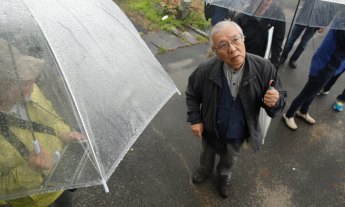
Chemist Rebecca Abergel and her colleagues have found a way to remove radioactive contaminants from the body. Now they are trying to put their solution in a pill.
After the US dropped atomic bombs on the cities of Hiroshima and Nagasaki at the end of World War Two, more than 100,000 people died — many from exposure to radiation. At high doses, radiation blasts through tissues, ruptures DNA strands and alters the rhythms of cell division. Disrupted cells cause nausea, diarrhea and fever, then dizziness, weakness and hair loss. Over time they may turn cancerous. For a person who has experienced high levels of radiation in a short period of time, from a nuclear weapon or a Chernobyl-scale nuclear power plant meltdown, treatment options are limited. Doctors can make a patient comfortable, treat burns and nausea, and try to keep the radiation from spreading. But an acute dose is usually fatal. The problem is, once radiation is in the body, it can be very hard to get out.
It may not have to be this way. Nuclear weapons and accidents commonly release actinides, a group of radioactive elements at the bottom of the periodic table. Actinides such as plutonium, uranium and curium easily lock into our bones and organs, where they can emit radiation into our bodies for decades. Chemist Rebecca Abergel and colleagues at Lawrence Berkeley National Laboratory, in California, have created molecules that bind to actinides to form large, stable complexes that are easier for the body to expel. She (TEDxAix Talk: Ambivalent radionuclides) shares more on the idea, not least that it’s been around for more than 60 years.
Hey, plutonium, you’re coming with me. Abergel’s team is developing chelators, naturally occurring molecules that can form multiple bonds to a single metal ion. Chelators are a long-established treatment for poisoning by heavy metals such as iron, arsenic and lead. (They have also been tried as risky “alternative” treatments for conditions like heart disease and autism; many doctors consider these uses of chelation to be controversial.) Abergel and her team at Berkeley have made a chelator that binds to actinides — without interfering with other metals that we need in our bodies, such as zinc or iron. The work is a continuation of research that started back in the 1950s, pretty much once people started realizing the potential havoc of nuclear warfare.
Building a chelator requires educated guessing and checking. To make their chelators, Abergel’s team worked with scaffolds inspired by the known molecular structures of iron-binding chelators in bacteria. They tinkered with parts of the scaffolds step by step, modifying properties such as the acidity and number of binding sites through a series of chemical reactions. They also tacked on additional arms. “Actinides are bigger than iron, so you need more coordinating atoms,” Abergel explains. Over the last 30 years, she and her colleagues have tested dozens of different structures. One removed 80 percent of contaminating plutonium from mice, in two days, with just a single dose.
Human trials for a radiation poisoning cure. Abergel’s team has already demonstrated the safety and efficacy of their chelators in human cell cultures and several animal models. Last year they received FDA approval for a clinical trial testing the safety of a chelator treatment in humans. This will give one dose of the chelator, first at extremely low levels and then at increasingly higher levels to healthy volunteers, to establish the safety of the chelators and pinpoint any side effects. The researchers will never do a “controlled” clinical trial on people because that would require contaminating humans with radioactive substances. Instead, they will compare their human trial data with their animal data to establish safe, effective doses in humans.
Now, to make an anti-radiation poisoning pill. It would be possible to deliver chelators via a pill or an injection, but Abergel much prefers the pill. “If there is a mass casualty where millions of people are contaminated, you don’t want to be handing out needles,” she says. “Pills are straightforward to distribute, and can easily be crushed into a powder and mixed into something like yogurt for children or elderly people.”
The imperfect science of determining dosage. Much of the work that lies ahead for Abergel is nailing down the details of how to administer such a pill. “In animal models we’ve been looking at different contamination and treatment scenarios,” she says. “If there’s a nuclear power plant accident, what happens if we give the treatment 24 hours after contamination? Two days after? Should people take one pill every day for two weeks or twice a week for one? When do we stop treatment?” Her team is also looking at uses outside large-scale catastrophes — for instance, how the drug might benefit people who are regularly exposed to small amounts of radioactivity, such as scientists, nuclear power plant workers and uranium miners. Such everyday use would be a first for Abergel: normally, the best-case scenario for her product is that it never be used at all. (Until now, her work has relied on funding from the US government, which would add any resulting decontamination drug to its stockpile for emergency use.)
Chelator as a legitimate cancer treatment? Abergel is now experimenting with using synthesized chelators as a way to introduce therapeutic actinides to the body to treat cancer. Her idea: to attach the actinide-chelator complex to another molecule, such as an antibody, that can recognize and attach to a cancer cell. To minimize damage to healthy cells, Abergel is choosing actinides that decay and exit the body quickly. Doctors could also add tracer compounds to the actinide-chelator complex, which would show as fluorescent under certain light. “So these new platforms could target the cancer cell, bring in the radionuclide that destroys everything around it, and we can also image it,” Abergel says. It is very, very early days here — don’t ask your doctor about it quite yet. But if it works, then that of course is one treatment that definitely would be used.
Photo: Dahlia An, Lawrence Berkeley National Laboratory.












